Your cart is currently empty!
What is Stoneware? A Complete Guide to Stoneware Pottery
Published:
Last Updated:
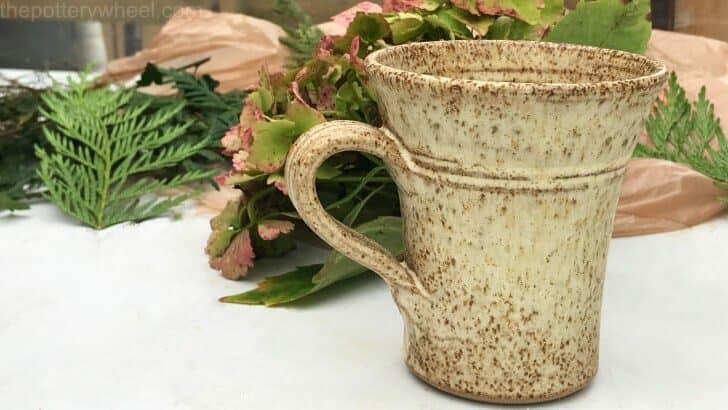
Affiliate Disclaimer
As an affiliate, we may earn a commission from qualifying purchases. We get commissions for purchases made through links on this website from Amazon and other third parties.
If you are starting out making pottery, or if you want to buy some ceramic dinnerware, you have probably heard the term ‘stoneware’. But what is stoneware and what are the advantages of using it? As a potter, I use stoneware clay every day, so I thought I’d write a helpful guide covering its best features and why you should love stoneware ceramics and clay as much as I do!
‘Stoneware’ refers to a particular type of ceramics that is known for being durable, non-porous, and often having a sturdy rustic appeal. It is also used to refer to a type of clay, from which stoneware pottery is made. You will hear cooks talking about stoneware plates and pots, and you will hear potters talking about stoneware clay and pottery.
So, that is stoneware in a nutshell. However, in this article, I will be diving deeper into the following areas:
- Stoneware pottery and dinnerware
- How does stoneware differ from earthenware
- How does stoneware differ from porcelain
- Stoneware pottery and glazing
- Glazed stoneware versus glazed earthenware
- Glazed stoneware versus glazed porcelain
- What is stoneware clay?
- How is stoneware clay made?
- The history of stoneware
- How is stoneware pottery made?
- The advantages of stoneware dinnerware
- The advantages of stoneware clay
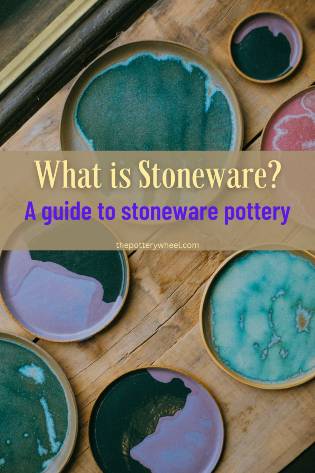
Stoneware Pottery and Dinnerware
All ceramic ware is made out of clay. There are different types of clay that produce different types of ceramic dinnerware, bakeware, and pottery.
The three main types of clay that are used to make ceramics are as follows:
- Stoneware
- Earthenware
- Porcelain
Each of these types of ceramics has different qualities that distinguish them from one another.
Stoneware ceramics are hard and strong. When ceramic ware is made, it goes through a process of being fired. This process takes place in a kiln, which is essentially a large oven that reaches very high temperatures. Stoneware ceramics are normally ‘fired’ or baked at temperatures over 2192F (1200C).
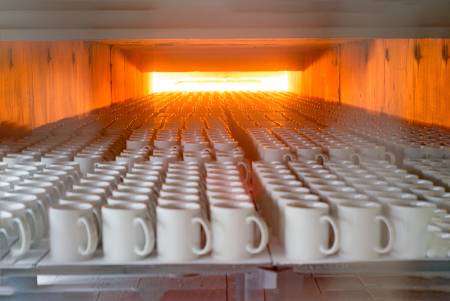
When ceramic ware is in the kiln, the clay goes through a lot of physical and chemical changes. It’s these changes that make the clay strong enough to be used as dinnerware.
One of the changes that stoneware goes through is a process called vitrification. This word sounds complex and off-putting, but it’s probably a term that you are already familiar with. You may well have heard ceramics being referred to as ‘vitreous’ and ‘non-vitreous’.
Here is a bit about what this means, and how it relates to ceramics…
What does Vitreous and Non-Vitreous Mean?
When clay is fired in the kiln, the clay particles undergo a lot of changes. One of the changes that occur is that the clay particles move closer together. In addition to this the surface of the particles bond together.
This is known as ‘sintering’. During the sintering process, the clay becomes denser as the particles move closer together. The bonded particles begin to form the basis of a matrix or structure in the clay that will become rigid and hard as the kiln and pottery cool down.
This structure is a bit like an internal skeleton in the clay that keeps the ceramic ware rigid once the clay has been fired. Although the clay particles have bonded together, there are tiny gaps or pores in between them. I tend to think of it as being a bit like sea coral, which is rigid and hard but contains small pores like a sponge.
Liquid Glass
All clay contains a mineral called silica, also known as quartz, which is an ingredient in glass. Some types of clay contain more silica than others.
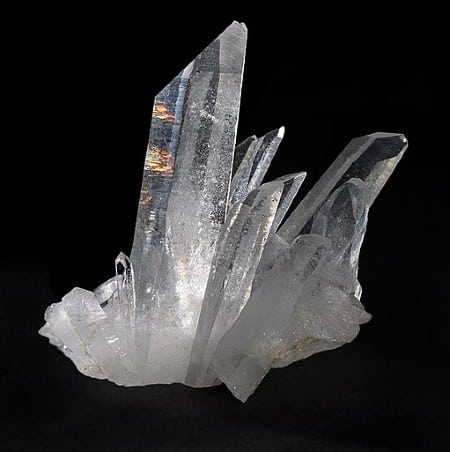
When clay is fired in a kiln, the silica melts and becomes liquid. In its melted state the silica flows into the tiny gaps between the clay particles. The silica acts on the clay particles causing them to flux (or melt too). As such, the silica and the clay particles create an intermingled material.
At this point, the pottery in the kiln is quite soft and bendy. The clay needs to be strong enough to support itself when it’s in this malleable state. Stoneware clay is strong enough so that it can be soft and malleable in the kiln without becoming deformed, bending, or collapsing in a melted puddle.
When the kiln and pottery cool, the intermingled molten glass becomes solid again. This creates a strong ceramic body. In addition to being strong, the ceramic ware is non-porous because the gaps between the clay particles have been filled up with glass. This is what is meant by the term ‘vitreous’.
In some types of clay, more of the pores are filled with liquid glass than in other types of clay. The more the pores are filled, the less porous the final piece of pottery will be.
Stoneware usually has a porosity of about 1-2%. This is low enough so that stoneware pottery is considered watertight and non-absorbent. The tough intermingled mixture of glass and clay also makes stoneware strong and resistant to being chipped or broken.
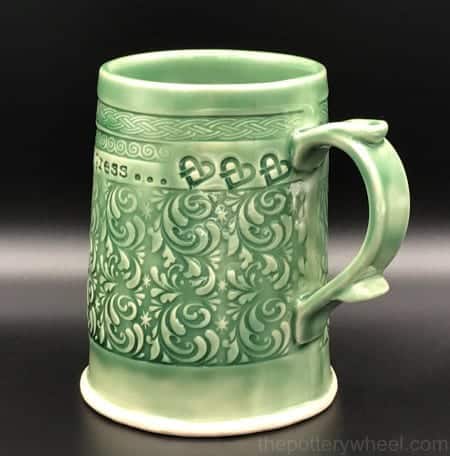
As such stoneware makes a good choice as kitchen and dinnerware because it doesn’t absorb food and liquid, even if it is not glazed. Glazing is the glass-like, often colored layer that covers the outside of ceramics.
How Does Stoneware Differ From Earthenware?
Like stoneware, earthenware is also fired in a kiln to make it become ceramic material. However, unlike stoneware, earthenware is still quite porous once it’s been fired.
Earthenware is sometimes defined as pottery that has more than 5% porosity, though it can be a much higher percentage than that.
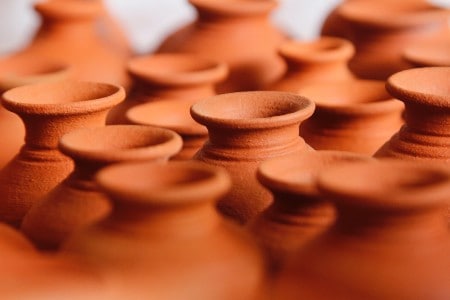
This means that earthenware pottery isn’t watertight and will absorb liquid from food and drink unless it’s been glazed well. Because it’s porous, earthenware clay is also less strong than stoneware and is more vulnerable to chipping and breaking in everyday use.
Earthenware pottery is more porous than stoneware because earthenware clay contains less of the glass-forming materials needed to become vitrified.
When earthenware pottery is fired, it reaches a high enough temperature to form some liquid glass. However, there is not enough molten glass to fill up all the gaps between the clay particles.
In addition to this, earthenware clay is not as strong as stoneware clay. So, when the clay becomes soft and bendy in the high temperature of the kiln, earthenware clay is less able to support itself and keep its shape.
The point at which earthenware pottery begins to warp, bend, and become deformed in the kiln is much earlier than stoneware clay. As a result, earthenware clay has to be fired at lower temperatures than stoneware.
Stoneware clay has more glass-forming ingredients, and it is stronger. So, it can be fired at higher temperatures and it can be fired for longer than earthenware clay. As a result, stoneware clay becomes more ‘mature’ when it’s fired, and is more fully vitrified.
How Does Stoneware Differ From Porcelain?
The other main type of ceramic ware mentioned above is porcelain. Like stoneware, porcelain is fired at higher temperatures than earthenware. And, similar to stoneware, porcelain ceramics are strong and non-porous. In fact, porcelain pottery generally has a porosity of less than 1%. And some porcelain is absolutely vitrified and is completely non-porous.
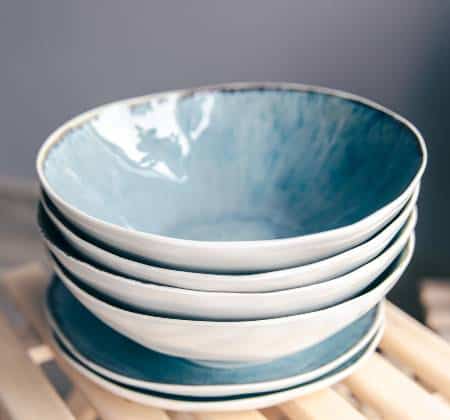
Porcelain pottery can often tolerate being fired up to the point where it has almost 0% porosity. This ceramic ware is very strong and durable, which is why porcelain is used for all sorts of purposes other than pottery. For example, certain types of porcelain are used in dentistry, and in surgery for joint replacements (source).
One of the reasons why porcelain is so strong is that it’s made up of particles that are similar in size. In other words, a porcelain clay body is consistent and homogenous. When it’s fired, all parts of the clay become equally vitrified.
By contrast, stoneware often contains particles of different sizes, like sand and grog. As a result, the vitrification isn’t quite as consistent in stoneware. And at a microscopic level, some areas of the stoneware are glassier and stronger than others.
In fact, often if you try to fire stoneware clay so that it has less than 1% porosity, it will lose strength and become more brittle and vulnerable to breaking.
Stoneware Pottery and Glazing
Because stoneware has such low porosity, provided it has been fired well and to the right temperature, glazing the pottery isn’t essential. Unglazed stoneware can be used and washed.
However, although it is not absorbent, the texture of stoneware is often a bit rough to the touch. It can have a toothy feel.
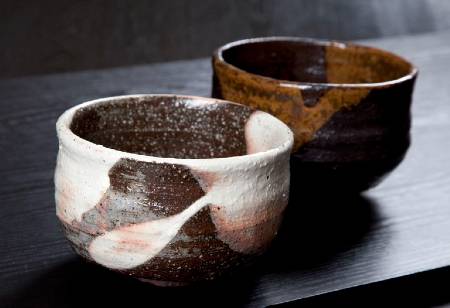
There are many different types of stoneware, and some are a lot grittier than others. However, even smooth stoneware has more of a tooth to it than for example unglazed porcelain which can feel as smooth as glass. Unglazed smooth stoneware can feel a bit like very fine sandpaper.
Because stoneware has an organic toothy feel, it can become discolored with time if it is being used without having been glazed.
So, usually, stoneware ceramics are glazed, especially in those areas that come into direct contact with food and drink.
Ceramic Glazes
There is a huge range of types of stoneware glaze. They can be glossy, matte, translucent, or opaque. They can also be designed to run and flow on the pottery as it’s fired, creating nice drips and pools of color. Or they can be designed to stay quite static on the glaze creating bold patterns or blocks of color.
These are just a few of the different types of glaze that are used on stoneware pottery. However, one thing that stoneware glazes usually have in common is that their colors are quite organic and earthy looking.
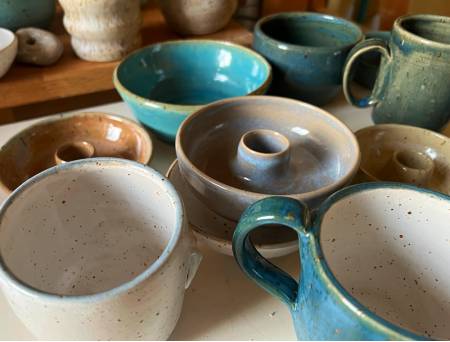
Greens, browns, reds, and even blues have a natural somewhat rustic look to them. This contrasts with the glazes used on earthenware ceramics.
Glazes on earthenware pottery can be brighter in color and are often primary colors with a high shine. Although some earthenware glazes are designed to look like stoneware glazes.
The reason for this is partly to do with the temperature at which stoneware and earthenware are fired. Earthenware ceramics are low-fire. This means that they are fired at the relatively low temperatures of 1852-2109F (1011-1154C). The bright colors in earthenware glazes can survive these temperatures quite easily.
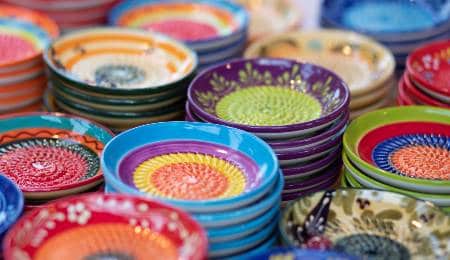
By contrast, stoneware pieces are mid to high-fire ceramics and are fired in the range of 2158 -2377 (1181-1303C). Bright primary colors, especially primary red colors don’t do well in this temperature range. So, colors for stoneware glazes tend to be earthy and organic rather than primary colors.
The Glazing Process
Before glaze is applied to pottery, it is made up of a combination of ingredients such as silica and alumina which are suspended in water.
This liquid is applied to bisque-fired ceramics. Generally, pottery is fired in two stages. The first stage is the bisque fire. During the bisque fire, the pottery is turned from soluble unfired clay to hard insoluble ceramics.
After the clay has been bisque fired, glaze is applied. It can either be poured or brushed onto the pottery if the potter is working on a smaller scale.
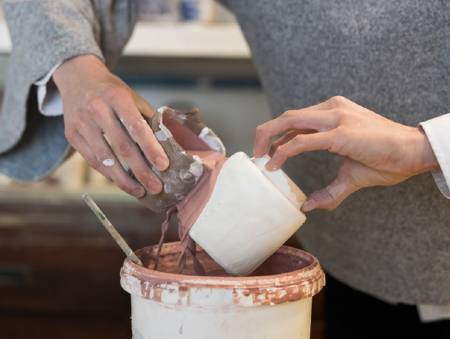
Or if larger amounts of pottery are being made, then often the bisqueware is dipped in the glaze. After the glaze has been applied, the pottery goes into the kiln for a second time to be glaze fired.
During the second firing, the ingredients in the glaze melt into a molten glassy mixture. When the kiln and ceramics cool the glaze becomes solid again and forms a glass coating on the pottery.
Glazed Stoneware Vs Glazed Earthenware
When pottery is glazed, the point at which the glaze meets the underlying ceramic body is called the clay glaze interface. The glaze bonds to the underlying clay body. The strength of this bond depends on the type of clay that has been used to make the ceramics.
As described above earthenware clay is fired at lower temperatures, and the clay itself does not become glassy or molten when it’s fired.
When earthenware clay is glazed, the glaze grips the rough texture on the surface of the pottery. The bond between the clay and the glaze is created by the glaze keying into the rough texture of the clay.
Something different happens when stoneware ceramics are glazed. As mentioned earlier stoneware clay has a higher glass content, which becomes molten during the firing process.
When glaze melts during the glaze fire, the molten glaze mingles with the liquid glass in the clay. This intermingled layer creates a very strong bond between the clay and the glaze.
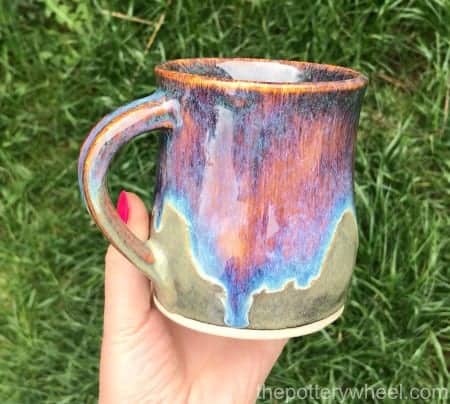
Rather than just sitting on the surface of the clay, like an earthenware glaze, stoneware glaze becomes part of the body of the ceramic ware. As such, stoneware glazes are strong and resilient to the bumps and knocks associated with everyday use in the kitchen and dining room.
Glazed Stoneware Vs Glazed Porcelain
Having said that, it’s worth mentioning that the strongest bond between clay and glaze is actually formed by glaze-fired porcelain. When porcelain is glaze fired, this intermingling spreads deeper throughout the clay and glaze and the interface is wider and more complete.
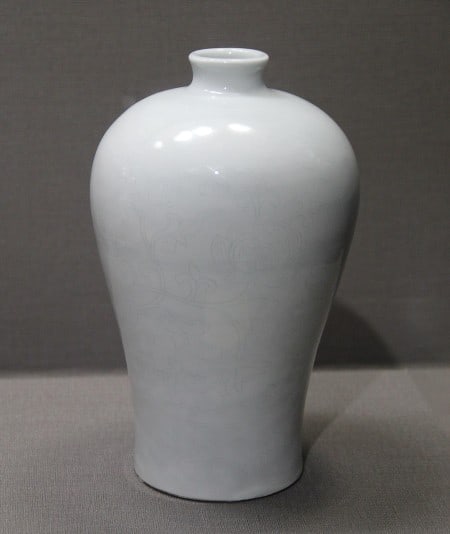
By contrast, when stoneware clay is fired, some integration takes place between clay and glaze. However, there is still some tension between the underlying clay body and the glaze that has been applied.
Because of this possible tension, it’s important to choose glazes for stoneware that are compatible with the underlying clay that has been used. Some glaze and clay combinations play nicely together. Others do not suit each other. This is known as clay glaze ‘fit’.
If a glaze doesn’t suit a particular type of stoneware clay, defects will show up in the fired stoneware. A common defect is ‘crazing’ where the glaze forms very fine cracks after the pottery has been taken out of the kiln.
You will know this is happening if your pottery is making a pinging noise when it’s removed from the kiln. It’s sometimes a matter of trial and error to find a glaze that suits a particular stoneware clay.
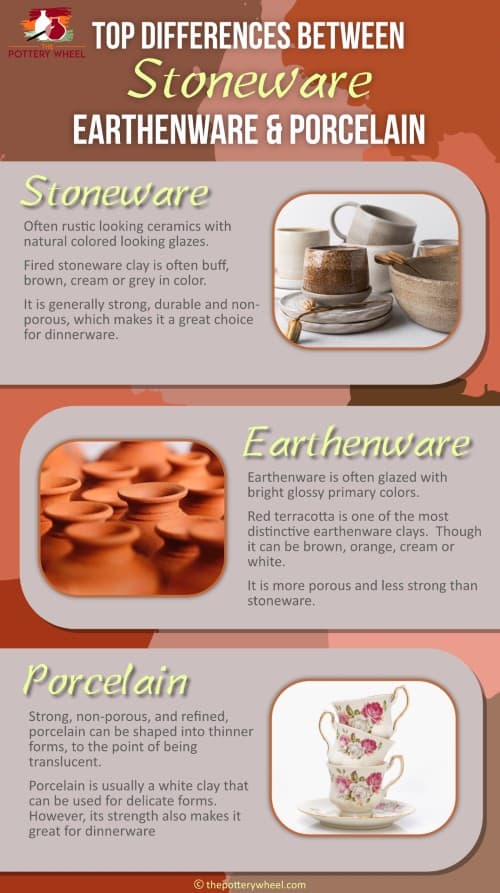
What is Stoneware Clay?
It’s amazing to think that the clay used to make dinnerware, mugs, and casserole dishes is made from particles of rock that formed millions of years ago. One of the main ingredients of clay is actually rock. Rocks such as granite or basalt are eroded by weather over millions of years.
The eroded particles either collect in the area where the erosion happens, or are carried to a different location by the wind, rain, and water.
Clay particles that collect at the point of erosion are quite pure. The clay that forms from these particles is called ‘primary clay’. Kaolin is an example of this. It’s a white clay that is used to make porcelain pottery clay.
By contrast, the particles of rock that are carried to a different location by wind and rain form what’s known as ‘secondary clay’.
Stoneware clay is a secondary clay. This clay picks up other minerals and impurities on its journey. It is these additional particles that give stoneware clay its color.
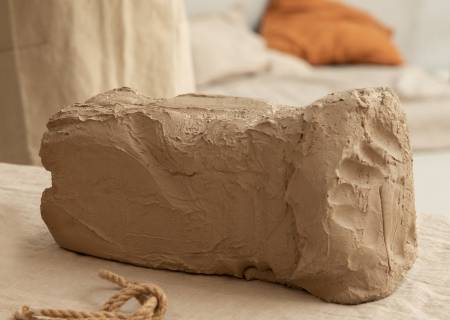
Stoneware clay is colored clay. Its color can be buff, yellow, orange, red, brown, or off-white. However, even light-colored stoneware that looks white when it’s fired is not the pure white color of porcelain.
How is Stoneware Clay Made?
Natural lumps of unprocessed clay are mined from the earth and taken to a processing plant. Here the large clumps of dirt are broken down, filtered, and milled to a fine powder.
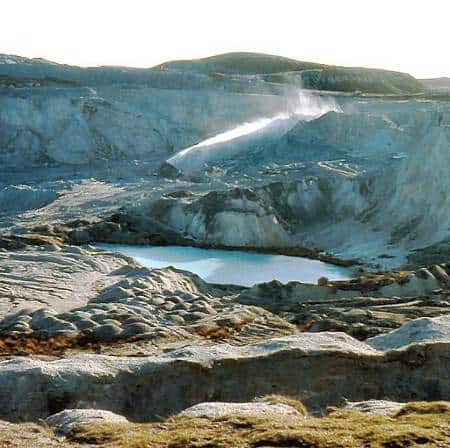
When this fine processed powder is mixed with water again, it makes up the lovely smooth clay that is used to make pottery.
All types of clay are made up of a combination of alumina and silica. However, different types of clay have different ratios of these two minerals. In addition to this, other ingredients are added to the clay to give the clay different qualities.
For example, stoneware is usually quite a plastic clay. ‘Plasticity’ in the world of pottery refers to clay that is soft and workable, but also that will keep its shape once it has been molded.
Plastic clay is not elastic in that doesn’t tend to return back to its original shape. It keeps its shape and it has enough strength to hold its form once it’s been made.
Another quality of plastic clay is that it can be bent and shaped without cracking or crumbling. Moist clay that cracks when it’s bent is described as being ‘short’.
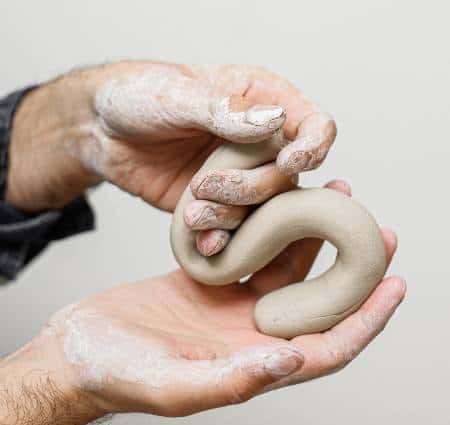
Stoneware clay is known for being plastic, moist and strong. One of the ways that stoneware clay is given these qualities is that ‘ball clay’ is added to the mixture in the processing plant.
Ball clay is very plastic because it is made of extremely fine particles. Another ingredient often added to stoneware clay is ‘fire clay’. Fire clay has a high firing temperature.
It is the addition of ingredients like ball clay and fire clay that give stoneware clay its plastic workable quality and enable it to be fired at high temperatures.
The History of Stoneware
Historians and archaeologists suggest the earliest evidence of pottery being made dates back to around 20,000 years ago. Sherds of pottery were found in the Xianrendong Cave in Eastern China (source).

Very early pottery was made out of earthenware clay. By contrast, stoneware pottery arrived on the scene, also in China during the Shang dynasty. This period in Chinese history spans 1600-1046 BCE. And the earliest piece of white stoneware found intact from that era is dated back to 1400BCE (source).
Porcelain pottery was also first created in China, but it appeared even later than stoneware. In fact, a primitive form of porcelain was first made during the Tang dynasty which occurred from 618-907. And a more sophisticated form of porcelain was produced later during the Yuan dynasty which stretched from 1279-1368 (source).
So, in a historical timeline, earthenware pottery was developed first, followed by stoneware, and then finally porcelain.
Stoneware pottery was also developed in other regions of the world, including Korea and Vietnam. And during the 12th to 14th century, it begins to make an appearance in Thailand.
In Europe, stoneware was produced from the late middle ages onwards between 1300-1500AD. This later appearance of stoneware was partly due to the fact in Europe the right type of clay was less readily available. But it was also because European kilns were less efficient at that time too. The production of stoneware in Britain began around the 16th Century.
It wasn’t until the middle of the 19th century that commercial stoneware started to be made in the US. Early American stoneware was largely very functional salt-glazed stoneware.
Early Stoneware Glazes
Over the thousands of years that stoneware ceramics have been produced, 3 main types of glaze have been used to give stoneware the qualities of toughness and durability.
These glazes include:
- Feldspathic glazes
- Ash glazing
- Salt glazing
Feldspathic Glazes
These glazes were often made of feldspar, silica, calcium, and clay. Metal oxides were added to give the glaze color. For example, iron oxide was added to create a celadon glaze. And copper oxide was added to create rich red glazes like the Oxblood glaze.
The Chinese developed many beautiful specialized glazes such as Hare’s fur, oil spot, and Chun glazes. They also developed Jian ware, which was later imitated by Japan to create Tenmoku glazes.
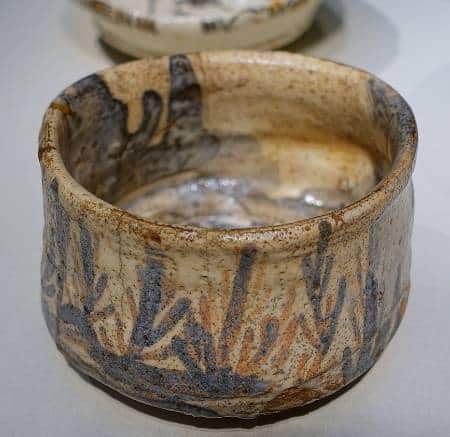
Daderot, Public domain, via Wikimedia Commons
These styles of glaze still appeal very much to potters today, and many commercial pottery manufacturers make stoneware glazes designed to recreate their original appeal.
Ash Glazing
Ash glazing also began in China in the Shang dynasty around 1500 BC. By accident, it was discovered that ash from the wood used to heat the kiln was creating a glaze on the ceramic surface.
As a result, the early Chinese potters began to add ash deliberately to the glaze and apply it to the pottery before it went into the kiln. Often the ash was mixed with clay or water to create a paste. This was then smeared onto the pots before firing.
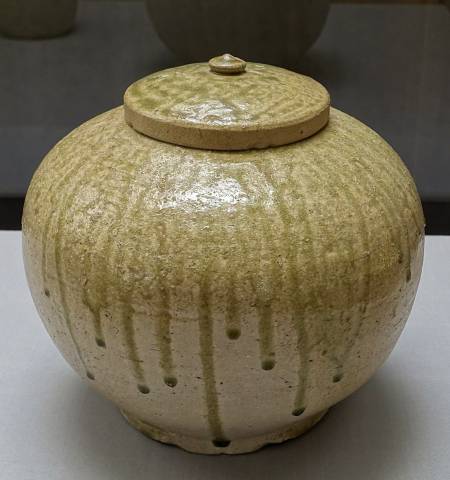
Image by Daderot, Public Domain, via Wikimedia Commons
Salt Glazing
During salt glazing, salt is introduced to the kiln when the kiln is about 2200F (1240C). When the salt enters the kiln it vaporizes and becomes gas.
The sodium oxide in the salt clings to the surface of the pottery in the kiln. As it clings it interacts with the silica and alumina oxide in the clay creating a glaze.
Salt glazing stoneware is thought to have originated in Germany in the 14th Century. Traditional salt-glazed pottery was made from buff, brown, or grey stoneware clay. It had a mottled, dimply texture often described as orange peel.
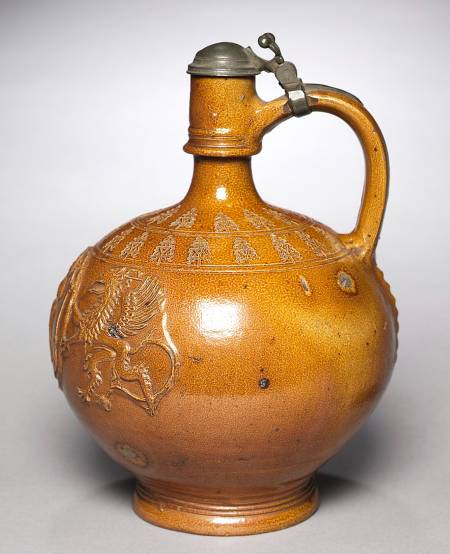
Cleveland Museum of Art, CC0, via Wikimedia Commons
Between the 18th and early 20th Centuries, salt glazing was used to create a lot of functional domestic pottery. However, the salt glazing process involves the discharge of hydrogen chloride out of the kiln into the surrounding atmosphere.
Environmental concerns have meant that salt glazing is no longer used for industrial-scale ceramic production. However, it is still made by smaller-scale studio potters. If you’d like to know more about salt glazing, you can check out my guide to salt glazing, past and present here.
Lead Glaze and Tin Glazing
Lead glaze contains lead oxide, which helps the silica in the glaze to melt at lower temperatures. Its use dates back to Roman times. However, it was mainly used on earthenware pottery.
And it was later discovered that lead could leach out of the glaze and contaminate food and drink. As such, lead glazing was eventually banned, and almost all commercially available glazes are labeled as ‘lead-free’ these days.
Tin glazing is a lead glaze with added tin oxide to create an opaque white glaze. Like lead glazing, this was largely used on earthenware ceramics rather than stoneware.
How is Stoneware Pottery Made?
There are 5 main ways that stoneware pottery is made. The method used depends, in part, on whether the stoneware is being made by a mass-production ceramics factory, or whether it’s a smaller-scale independent potter at work.
Here are some of the ways that stoneware pottery can be made:
Method 1) Wheel Throwing Stoneware:
There are lots of different types of potters wheels. Some are electric and some are operated manually by a foot lever or pedal. What they share in common is that they consist of a flat circular plinth that is mounted on a shaft that rotates.
Clay is positioned on the center of the plinth, and the potter used their hands to shape the clay as it turns beneath their fingers.
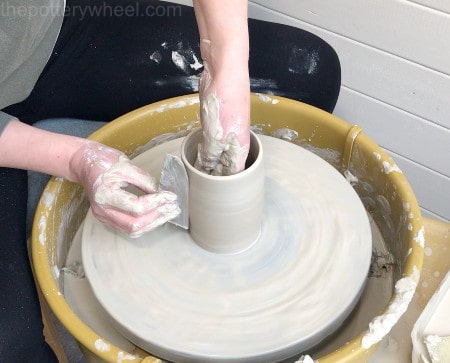
The name wheel ‘throwing’ is curious and comes from the old English word ‘thawan’, which means twist or turn. If you want to know more about the mechanics and technique of wheel throwing, you can check out my guide on that here.
Method 2) Hand Building Stoneware:
Another way to make pottery is to build it with your hands. Not surprisingly, this is called ‘hand building’.
There are 3 main ways to make pottery by hand, and they include pinching the clay into shape, using coils of clay, or using slabs of clay.
Each of these techniques involves manually shaping the clay with your hands. In many ways, hand building is a lot like modeling with clay and can also be a little like sculpting.
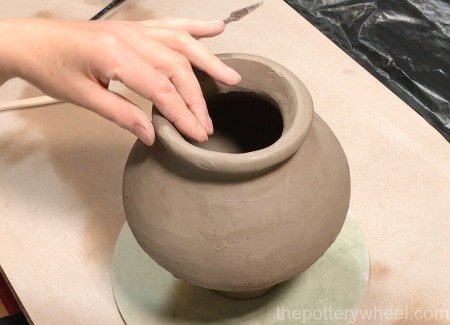
Hand building with clay is extremely satisfying and can create beautiful, unique, and organic-looking pottery. However, it does take longer than wheel throwing, so if you want to make large quantities of stoneware pottery, there are faster ways of achieving that.
This brings me neatly to the next way to make stoneware, which is slip casting.
Method 3: Slip Casting Stoneware:
Slip casting is often used to make stoneware pottery on a larger scale. The reason for that is that the process makes mass production just a little bit easier.
In ceramics, the term ‘slip’ refers to a mixture of clay and water. It’s a creamy liquid form of clay. ‘Casting slip’ is a particularly smooth, refined pourable kind of clay slip.
The slip-casting process involves making an original piece of pottery out of clay. A plaster mold is then made of the original piece of work.
Casting slip is then poured into the mold to make a cast replica of the original pottery item. The plaster draws the liquid out of the clay slip and the clay becomes solid in the mold. After it has solidified, the cast can be removed to reveal a replica of the original piece.
The benefits of slip casting are that once the original and the cast have been made, many identical copies of the original piece can be made relatively quickly. This helps in the large-scale production of stoneware.
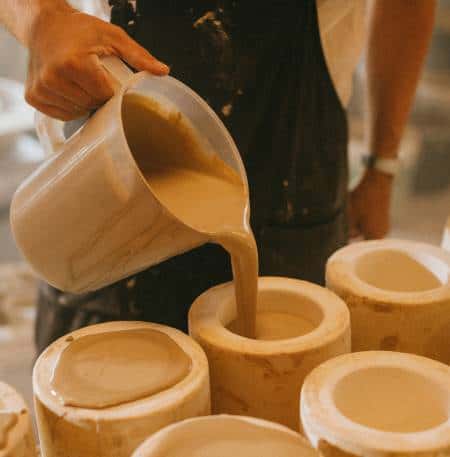
Method 4) Jiggering and Jollying Stoneware:
An alternative way to make stoneware is to use a jigger or a jolly. These whimsical names refer to two types of plaster molds that are shaped by a die.
Jiggering
A jigger is a plaster mold, with a convex shape. That means, the plaster mold curves outwards in the shape that you want your pottery to be.
The jigger is then attached to the wheel head on a pottery wheel and rotates as the wheel head turns.
A slab of clay is pressed onto the plaster mold and the wheel head starts to turn. Another piece of equipment called a jigger arm is then used to mold the clay precisely into the shape of the mold.
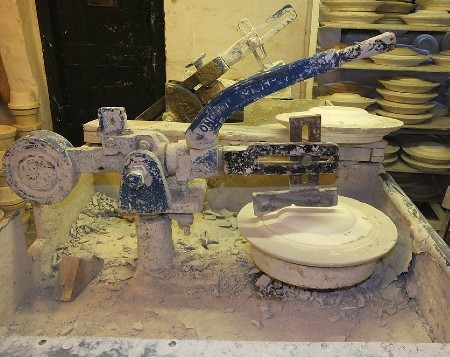
(CC BY-SA 3.0), via Wikimedia Commons
The Jigger arm is a lever that is lowered over the rotating clay. A ‘die’ or shaped template, is attached to the end of the jigger arm. As the clay rotates underneath the jigger arm, the die scrapes away the excess clay and molds the clay into the shape of the die.
Jollying
A Jolly works on a similar principle to a jigger. The difference is that the jolly mold is concave, meaning it curves inwards. Like the jigger, the jolly mold is attached to the wheelhead and a lever is lowered down over the jolly as it rotates.
However, with a jolly, the jolly template on the end of the arm presses the clay out into the concave shape of the mold.
Method 5) Ram Pressed Stoneware:
One final way of producing pottery is to use a ram press. This consists of two plaster molds that are pressed together by a hydraulic machine.
The plaster molds fit together nicely to create the shape of the clay item that is being produced. These molds are mounted onto the ram press, and clay is positioned on the lower mold.
The two sides of the ram press then move together, pressing the clay into the desired shape. Once shaped, the clay can be removed from the press and trimmed.
The Advantages of Stoneware Dinnerware
When I use the term dinnerware, I’m referring to all types of functional ceramicware that are used for food and drink. Stoneware has some definite advantages when it’s being used for dinnerware.
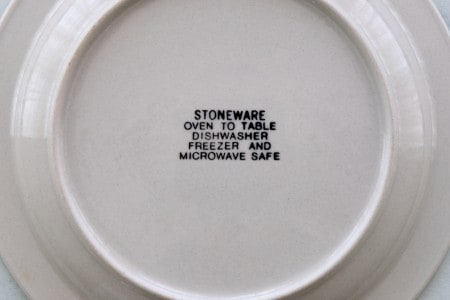
The following advantages make stoneware a popular choice amongst independent potters and larger-scale manufacturers.
- Stoneware is tougher and more durable than earthenware clay
- It is either vitreous or semi-vitreous which makes stoneware clay non-porous
- Stoneware ceramics are often less expensive than porcelain ware
- It often has a rustic, organic look which can be very appealing, especially when combined with the right glaze
- Provided it’s fired and glazed well, stoneware can usually be cleaned in the dishwasher
- Stoneware can usually be used in the microwave provided it isn’t decorated with metallic glazes
The Advantages of Stoneware Clay
Although some potters passionately prefer using porcelain clay, stoneware also has its ardent supporters including myself. Part of the reason for this is that I find it more cooperative and less fussy than porcelain clay.
- Some other reasons that stoneware clay is a popular choice amongst potters are as follows…
- It is generally plastic and workable, which means it’s easy to shape, and will hold its form once made
- A lot of stoneware clay can feel smooth and silky to use unless it contains added sand or grog which makes it grittier to handle.
- Stoneware is often (though not always!) fired at lower temperatures than porcelain. As a result, it is more fuel efficient and puts the kiln under less strain each time it’s fired.
Final Thoughts
Potters do tend to become passionate advocates of the kind of clay that they use. They develop a relationship with the clay and like any relationship with time you get to know each other’s strengths, weaknesses, and quirks.
Although I do sometimes flirt with earthenware and I will dabble with porcelain, my heart belongs to stoneware. I hope that this guide has encouraged you to get to know stoneware too.



